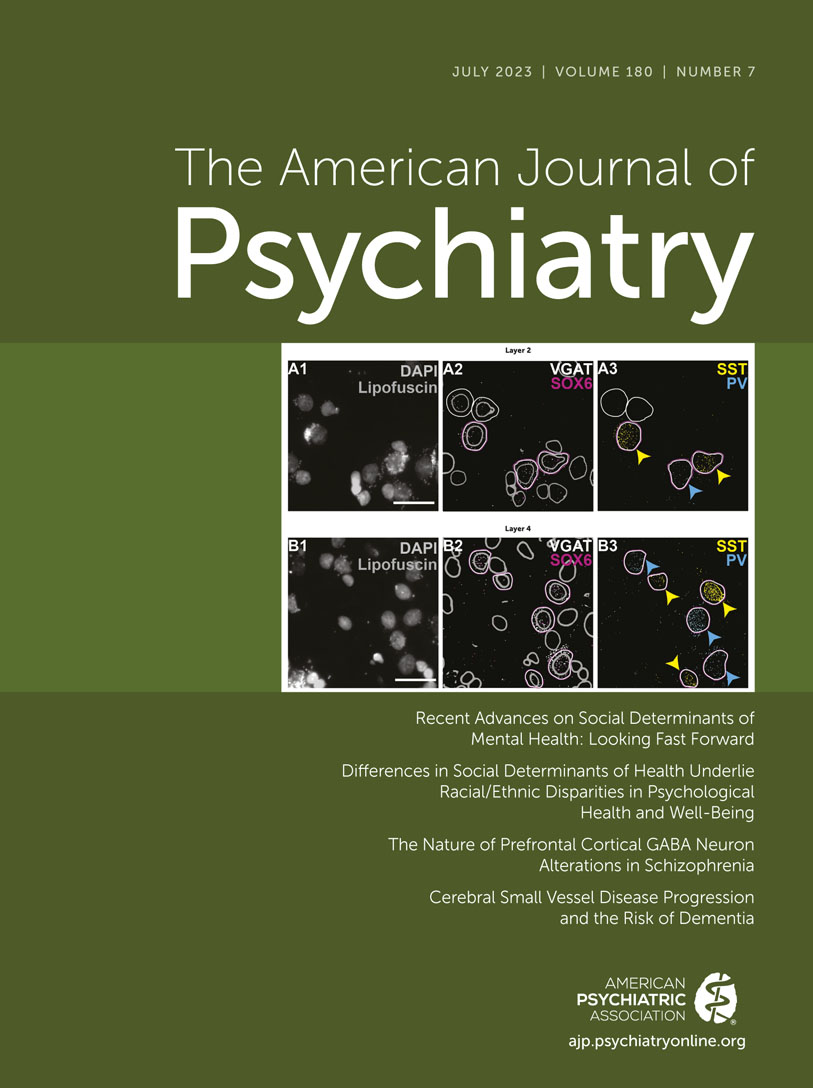The constructs “race” and “ethnicity” have been traditionally used in the process of documenting health and mental health disparities in the United States. However, simply noting racial/ethnic background has led to many inaccuracies and misunderstandings. Regrettably, this approach exacerbates health inequities, and it persists in health care and medical research (
1). Race and ethnicity are generally self-reported and relate to an individual’s ancestry and physical appearance, particularly the color of the skin. Focusing exclusively on self-reported ethnicity and skin color may obscure other characteristics critical for ensuring scientific accuracy, providing health care, and overcoming health disparities (
2–
4). Indeed, concepts of race and ethnicity are quite dynamic and are shaped by geography, culture, ancestry, population heterogeneity, and sociopolitical forces. The separation of people into distinct race/ethnicity categories, while convenient for governmental purposes, may have contributed to implicit biases (e.g., superior versus inferior) and may have encouraged discrimination, unequal treatment, and racism. The convincing argument that race is a social construct and not a biological one followed the observations of geneticist Richard Lewontin, who reported that most genetic variation was found between individuals, not across racial groups, and that there was no evidence to support the concept of “biological race” (
5). Data emerging from the human genome project did not provide any clear, documentable evidence for racial distinctions either (
6). These observations soon led to the dismissal of “biological race” as a concept and to a new perspective that views race entirely as a social construct (
7). Focusing exclusively on the social aspects of race and ethnicity may also lead to inaccurate conclusions; this was observed in recent reports showing that pulse oximetry overestimates arterial oxygen saturation in Black, Asian, and Hispanic patients compared with White patients, which contributed to delays in implementation of COVID-19 therapies. While these findings were initially attributed to racial bias (
8,
9), a subsequent report (
10) accurately pointed out that such results were related to darker skin color rather than racial bias per se. The concern here is that some of these reports are disseminated quickly across the news media as proof of structural racism in health care, which was clearly inaccurate in this instance.
The debate about the use of race/ethnicity constructs in clinical practice or biomedical research often ends with an either/or conclusion. Either these constructs provide substantial benefits, or they have no place in scientific discourse. This debate among epidemiologists, geneticists, clinicians, social scientists, and other experts is not yet resolved and is likely to continue for the foreseeable future. Proponents of new social theories, such as “critical race theory” (
11), insist that institutions in the United States are inherently racist and thus maintain social, economic, and political inequalities. These theories have influenced scholarship in several fields, including health care and health sciences. The conflict between proponents and opponents of these initiatives follows political lines, and legislation introduced in several states either amplifies or restricts the discussion of these potentially divisive concepts in public institutions. Stepping out of this political minefield, it seems obvious that, at least from a practical perspective, the presumably inclusive categories of race/ethnicity will continue to be used as key variables in assessing health and mental health disparities. These categories remain officially incorporated in U.S. Census assessments and the portfolios of U.S. federal agencies (e.g., the Food and Drug Administration) and research institutes (e.g., the National Institutes of Health [NIH]), and as a consequence, it is expected that they will continue to be used in scientific research and publications.
Health disparities related to race/ethnicity have been the subject of several debates and expert panels convened by NIH, the National Academy of Medicine, and other leading institutional organizations in the United States. A joint workshop convened by NIH’s National Human Genome Research Institute and the National Institute on Minority Health and Health Disparities examined the available evidence related to race/ethnicity in the institutes’ research portfolios and emphasized the need for future studies to capture self-identified race and ethnicity data, social and cultural identity, family background, and ancestry data derived from genomic analyses. A key statement from that consensus conference was that “it is time for the broader scientific community to develop and adopt consensus practices for the use of race, ethnicity, social determinants of health and ancestry data for study design, interpretation of results, publications and medical care” (
12). Given the positive impact that an increased awareness of race/ethnicity issues may bring for the implementation of specific interventions that decrease health disparities, national medical associations and biomedical journals are giving priority to research and publications addressing these issues (
13,
14). Ultimately, the value of this approach should be reflected in specific outcomes and in clearly stated limitations of data generalizability.
The information used to categorize race and ethnicity is generated almost exclusively through self-report, a process that involves implicit biases and inaccuracies, including the potential stigma of the label and the imprecisions of lumping individuals into “monolithic” groups that may be quite heterogeneous. Therefore, identifying measurable and predictable correlates of race/ethnicity from among the large set of social determinants of health (SDoH) may provide a new approach to examine disparities, yield more practical information, and possibly allow for the development of more successful interventions. It may also provide a work-around for careful examination of polarizing issues.
A good example of a relevant subset of SDoH is educational attainment because it is a proven marker of health disparities affecting African American and Latinx populations in the United States, which have been historically disadvantaged by American school systems. One core issue is that the wealth of Latinx and African American households has been estimated to be less than one-fifth that of White households (
15). Moreover, recent reports (
16,
17) highlight the fact that the United States stands out as a case study of the impact of extremes in school financing that privileges affluent neighborhoods and underinvests in low-income school districts that are epicenters of health and mental health disparities. Thus, level of education predictably influences downstream SDoH, and simultaneously, SDoH structure the quality of the education received (
16,
17).
The paper by Jester et al. in this issue of the
Journal (
18) is a welcome addition to this area, as it provides sophisticated secondary analyses of a carefully conceived and documented data set. This paper addresses a high priority area for the
Journal, as it relates to racial and ethnic issues as determinants of mental well-being. As noted by the authors, the origins of most health disparities are complex and difficult to disentangle because structural racism and discrimination have shaped the SDoH among marginalized adults in the United States and will likely continue to do so for the foreseeable future. Therefore, understanding the effects of SDoH on psychological health and well-being across racial and ethnic groups seems crucial for the development of prevention strategies, such as policies targeting socioenvironmental risk factors at a population level, at an early age, to prevent downstream disadvantages and morbidity. The identification of key SDoH as drivers of racial and ethnic disparities in psychological health and well-being should guide government agencies and health care systems toward a better allocation of resources to interventions and policies that appreciably reduce health inequities.
As part of this initiative, the authors examined the impact of selected SDoH on psychological well-being (depression, cognition, and self-rated health) in a large sample of older individuals (more than 11,000 participants 51–89 years of age) who took part in the Health and Retirement Study and were categorized into Black, Hispanic/Latinx, and White racial/ethnic groups. Selected SDoH included education, years worked, income, insurance coverage, veteran status, geographic location, and nativity status. Utilizing sophisticated methodologies, the authors found that differences in key SDoH, including education, income, years worked, and insurance parity, underlie racial/ethnic disparities in depression, cognition, and self-rated health of older adults. Thus, SDoH were associated with a significantly larger proportion of Black–White disparities in depressive symptoms (51%), cognition (39%), and self-rated health (37%), but age, sex, health-related measures, and health care utilization were not. In the case of Hispanic/Latinx individuals, analyses showed that SDoH were associated with disparities in cognition (76%) and self-rated health (75%).
While the impact of these variables on health outcomes is well known, in our view, this is the first time that these inequalities have been so unambiguously delineated in the context of a large, respectable data set. Unfortunately, among the limitations of this data set are that it is restricted to older adults and includes only White, Black, and Hispanic individuals. Therefore, the possibility of modifying the impact of many of these SDoH in the studied population seems quite limited, and the results cannot be generalized to other racial/ethnic groups.
As noted by the authors, some SDoH are more modifiable than others. For example, attitudes toward health and health-related behaviors can be positively influenced through appropriate counseling and education. Other SDoH are related to environmental contingencies that may be changeable (e.g., affordability of and access to health care). However, many other SDoH seem much more difficult to alter or modify, particularly in the case of older age groups. These include quality of childhood education, nativity status, occupational history, and income. Given the availability of other large data sets, one would hope that investigators will use similar strategies to elucidate specific, modifiable SDoH in the context of other populations and data sets that might eventually lead to successful interventions.
The clinical implications of these findings are an increased awareness of the inequalities affecting Black and Hispanic populations in the United States and a better understanding of how social determinants lead to these disparities and exert a negative impact on health status and certain types of psychopathology. Moreover, these results highlight the relevance of integrating this knowledge into future mental health interventions that may be applied across the lifespan.

